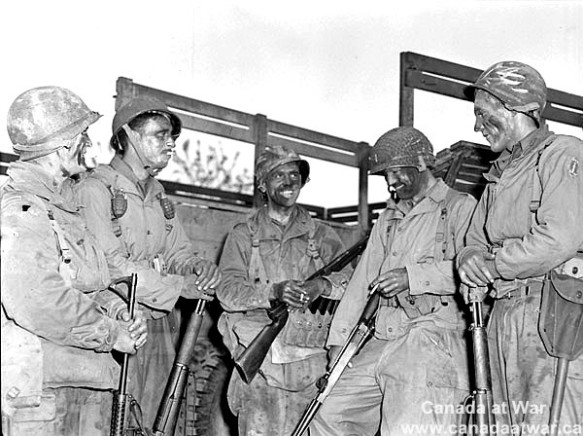
Robert T. Frederick as a brigadier general, while commanding the 1st Special Service Force.
Italy, October 1943 to June 1944
Popularly known as the Devil’s Brigade, the 1st Special Service Force (FSSF) was a joint American-Canadian commando-style unit originally raised to operate in Norway in an attempt to prevent the Germans from obtaining that country’s critical raw materials and to knockout strategic targets such as hydroelectric power plants.
Originally conceived as a three-battalion force, initially 1600 volunteers were carefully selected with preference being given to men previously employed as lumberjacks, forest rangers, hunters, game wardens and the like. Approximately one-third of the unit’s enlisted personnel were drawn from the Canadian Army and approximately half the officers and NCOs were Canadians. The force was activated on 20 July 1942 at Fort Harrison near Helena, Montana under the command of LTC Robert T. Frederick.
The initial training period was rigorous and intensive. Training included stealth tactics, hand-to-hand fighting, demolitions, amphibious warfare, rock climbing, mountain combat, winter operations, skiing, and parachute jumping. Every man in the force was a qualified parachutist.
The originally planned mission to Norway was eventually cancelled. In August 1943 the FSSF participated in the unopposed retaking of several islands in the Aleutians.
In October 1943, the FSSF was in Italy and assigned to the US Fifth Army. Previously a twelve-day attack on Mount la Difense had been stopped cold by the veteran German 104. Panzergrenadier Regiment. Attacking the peak from the rear up the steep cliffs, the FSSF cleared the summit (a feat immortalized in the 1968 motion picture The Devil’s Brigade). That was followed by Monte la Remetanea. It was in their next battle at Mount Sammucro that the Germans tagged them with the nickname of the “Black Devils” (because the brigade’s members smeared their faces with black boot polish for their covert night operations).
Radicosa, Mount Majo and Monte Vischiataro followed in January 1944 but by 8 January the 1800 men making up the initial combat strength of the FSSF had dropped to just over 500 effectives.
At the end of January 1944, the FSSF went into the Anzio beachhead, where for the next 90 days they occupied defensive positions opposite the crack Hermann Goring Panzer Division and often terrorized the Germans with their nighttime raids. Replacements arrived during that period and on 23 May 1944 they moved forward again, leading the advance of the US VI Corps towards Rome. On 4 June the FSSF was the first unit sent into Rome with the assignment of capturing seven essential bridges intact. By the time the parades and celebrations started, the FSSF was again in combat along the twenty-mile front of the Tiber River.
France, August 1944 to December 1944
Moved out of the line for refitting, they were soon back to their old tricks, nearly every man was seen driving his own jeep, each of which had been liberated from some other unit. On 23 June, Frederick was promoted and transferred to command the 1st Airborne Task Force. The FSSF then began training for its last real combat role – the invasion of southern France on 15 August 1944. The FSSF’s assignment was to seize two of three small islands between Toulon and the Riviera where there were ancient forts that the Germans had strengthened. By taking them, the FSSF would protect the invasion force from enfilading fire from the left flank.
With a little help from the Navy and the U. S. Army Air Forces, the FSSF men crawled, charged, and blasted their way into the German fortifications on Ile de Port-Cros and Ile du Levant, losing many good men due to unnecessary acts of bravado. “The men were too courageous,” one FSSF man said later. “They had a mistaken concept that courage and physical fitness were all that was necessary.”
While the rest of the Seventh Army moved northward through southeastern France the FSSF, however, was sent eastward along the Riviera against substandard, rear-guard enemy units, finally taking up positions along the French- Italian border. There the men stayed, their prodigious fighting talents wasting away as the war moved on.
The FSSF’s days were numbered. Without Frederick at the helm, and unable to find the calibre of men necessary to fill out its diminished ranks and carry on its glorious tradition, the FSSF was doomed to be disbanded on 5 December, its officers and men reassigned to other units.
In December 1944 Frederick was made commanding general of the 45th Infantry Division, which was locked in fighting in the Vosges Mountains, close to the German border. Wounded nine times during the war, Frederick was praised by Churchill as “the greatest fighting general of all time.”